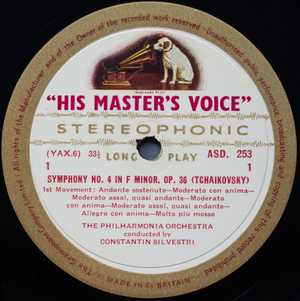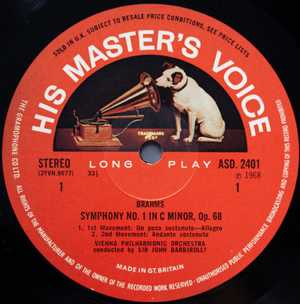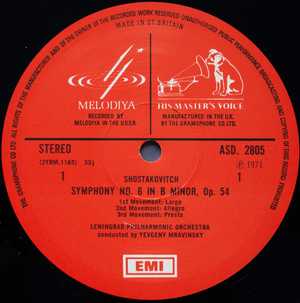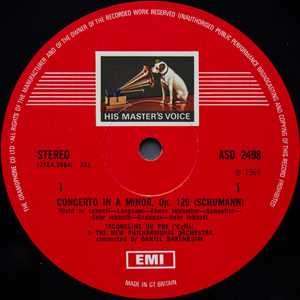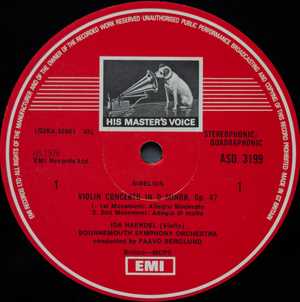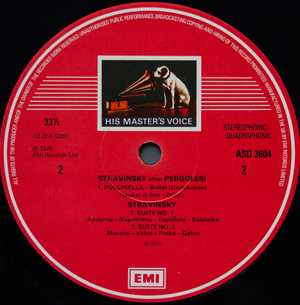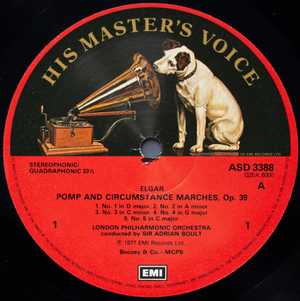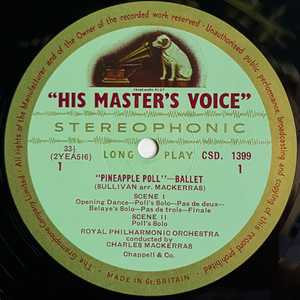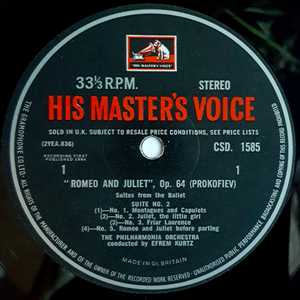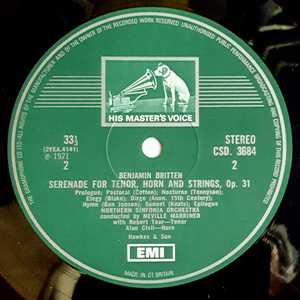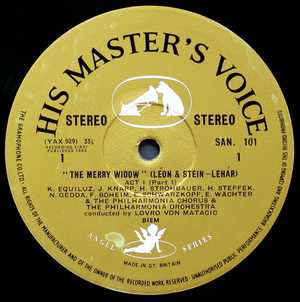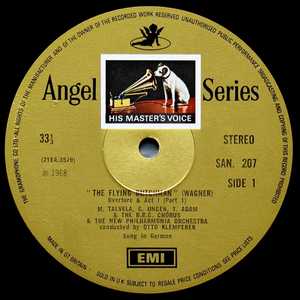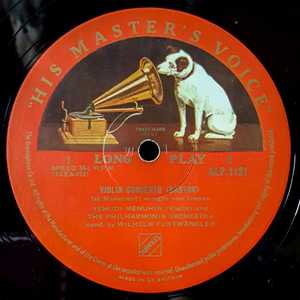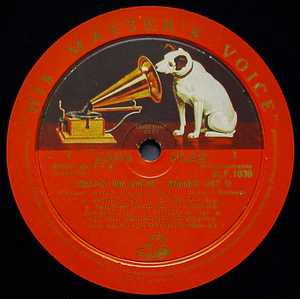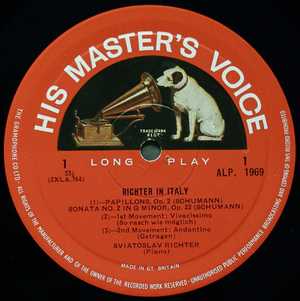-
Guide to Collecting: His Master's Voice (HMV)
HMV used the iconic picture of a white dog listening to his master's voice through the horn of an early gramophone. HMV was owned by EMI
HMV started issuing LPs in 1952, and started issuing stereo LPs in 1958. Throughout the LP era, HMV prided itself on producing very fine-sounding LPs.
HMV ASD series
The earliest ASDs have 3 digits after ASD. The first one is ASD 251 Scheherazade, conducted Beecham, and was issued in 1958, and the last one was ASD 655, Jacqueline Du Pre and Janet Baker, conducted Barbirolli, issued in 1965.
White/gold
From ASD 251 to ASD 575, the first label is called “white/gold”
Semi-circle
From ASD 576 up to ASD 655 the original label is “semi-circle”. The label shows the painting of “Nipper”, the HMV dog, hearing His Masters Voice through the horn of an early gramophone. The picture is in a semi-circle with HIS MASTER’S VOICE in white above it.
This is also the original label for the some of the ASD four digit record codes. These start with ASD 2251, Schubert Symphony no 9 conducted Barbirolli, issued 1966. The last semi-circle label ASD is ASD 2478, Menuhin conducting Schubert, issued in 1969. There is no semi-circle label for ASD 2476, Barenboim playing Bartok.
HMV/Melodiya
Just to confuse us, there’s a lot of ASDs below ASD 2478 where there is no semi-circle label. These are LPs that were recorded by Melodiya in the USSR and pressed by HMV in the UK. (Clearly Melodiya was making very fine recordings). These are HMV/Melodiya. The first of these that I know of is ASD 2406 Soviet Army Chorus issued in 1968. This is their original label:
Just like the UK recorded ASDs, the HMV/Melodiyas have superb sound.
Early coloured dog/stamp
From ASD 2484 (Barenboim playing Mozart) onwards the original label for the UK recordings is “early coloured dog/stamp”.
The coloured “dog/stamp” is easy to identify. The dog Nipper is in rectangle that’s a bit like a postage stamp. But this “early” dog in stamp label mustn’t be confused with the “late” dog in stamp from the early 1980s. This “early” or “original” dog in stamp is on a solid red background. (The “late coloured dog/stamp” has a white circle round the edge of the label).
The last early coloured dog/stamp I know of is ASD 2812 Boult conducting Wagner, issued in 1972. But there are many ASD numbers before this where the original label is the next label: “black & white dog/stamp”. One example of this is ASD 2719, Klemperer conducting Bruckner, issue 1972.
Black & white dog/stamp
So what does the “black & white dog/stamp” label look like? As you can no doubt guess the picture of Nipper in the rectangle is in black & white rather than colour. And it has a white line round the circumference.
The last black/white dog/stamp I have seen is ASD 3825
Late coloured dog/stamp
Then comes the late coloured dog/stamp which has a white line round the circumference.
Large dog
The last HMV label is the “large dog” label. These are often German pressings.
Which HMV ASD label should you buy?
Nearly all the HMV pressings have superb sound, when they are the original label for that record code. I find that the second label for the early ASDs also have superb sound, and slightly quieter vinyl. I find both the early white/gold label, and the semi-circle label, whether original or second label, are wonderful.
Black/white dog stamps are also splendid, when they are the original label for that issue. I have occasionally been disappointed when they are not the original label, but that disappointment is rare. The HMV/Melodiyas show how good the Russian recordings are. When combined with the UK pressings they are outstanding.
HMV CSD series
CSD is a HMV stereo label, very similar to ASD in sound. Many of the HMV CSD issues are non-classical, but there are many outstanding classical issues too. Some of the notable conductors on this label are Colin Davis, Goossens, Irving, Kurtz, Mackerras, Sargent, Silvestri, Susskind, Weldon. Outstanding artists include Jaqueline du Pre, Moura Lympany, Moiseiwitsch, Tortelier
The first CSD label is very similar to the ASD white/gold label, but the background is pale green instead of white,
Original green/gold label
The CSD series starts with CSD 1251 which is non-classical. CSD 1252 is Ballet Music conducted by Irving, issued in 1958
The last green/gold CSD I’ve had is CSD 1503, British Light Music of the 20th Century conducted by Weldon, issued in 1963
The next label is
Original red/black label
These were issued between 1963 & 1969, the first classical issue on this label I've had is CSD 1512, Bach Cantata no 147 conducted by Geraint Jones. The last one I've had is CSD 3660, Elgar Sacred Music , sung by the Choir of Worcester Cathedral.
The last CSD label is a green dog/stamp label
Dog/stamp label
Which CSD label should you buy?
It's well worth looking out for CSD green/gold label issues, with the same outstanding sound as ASD white/gold. The red/black label is equivalent to ASD semi-circle labels, and again should give splendid sound. The dog/stamp label is equivalent to ASD dog/stamp labels, and again will give excellent sound.
HMV SLS boxed sets
Early HMV boxed sets were issued as ASDs, such as ASD 331/3, Carmen. There are three series, the 3 digit series starting with SLS 751 (more commonly listed as ASD 274/7), and ending with SLS 999, in 1977. The SLS 5000 series started in 1974, so the two series ran in parallel for a while. The highest SLS 5000 series I've seen is SLS 5289 issued in 1983. I've called the SLSs "boxed sets" but a few of them were issued as 2 LPs in a gatefold sleeve, such as SLS 5177, Shostakovich, conducted by Berglund. From 1983 onwards the SLS issues have 7 digits, beginning with either 1 or 2.
What labels do SLSs have? White/gold boxed sets and semi-circle boxed sets are usually listed under their ASD numbers. The ones usually listed as SLS have dog/stamp labels - original coloured dog stamp onwards.
SLS boxed sets have the same superb sound qualities as their ASD equivalents
HMV SAN Angel series
Many Opera and vocal sets were issued in the SAN series, and included librettos, even if there was only 1 LP in the set, such as SAN 107, Cluytens conducting Faure's Requiem, and SAN 162, Carmina Burana. HMV started issuing SANs in 1963, with SAN 101/2. They were issued in gatefold sleeves if there was 1 or 2 records, boxes if there were 3 or more records. The first label was original white angel/gold label.
The last white angel/gold label I know of was SAN 210/3, issued in 1968. The second label, gold label/black angel was used till 1971.
Both white angel/gold issues and gold label/black angel issues have superb sound.
The third label is yellow, with a coloured dog/stamp. The first original yellow label that I know of is SAN 291
HMV ALP mono labels
Walter Legge, the very influential Producer for HMV, was unconvinced by stereo initially so his late 1950s & early 1960s mono recordings are very fine, and rival the early stereos.
HMV, started issuing mono ALP records in 1952, starting with ALP 1001, Cantelli conducting Tchaikovsky's Symphony no 5. The original label was red/gold. The last red/gold label that I know of was ALP 1960, Stravinsky's Oedipus Rex, issued in 1963. That's a mono issue of ASD 511, as we're well into the stereo era by 1963.
The very earliest ALP issues have a heavy, flat pressing, and the label says "Non breakable" above the record code. (Though I have found a heavy, flat pressing of an early ALP that doesn't say "Non breakable"). They have a deep groove about 1 cm from the edge of the label.
Most ALP pressings are "groove guard" pressings. The rim has a slightly raised area. If you feel the edge of the record through the inner sleeve you can feel the raised rim. This was to protect the record when an auto-changer turntable was used. Auto-changers had a long spindle, and several records could be loaded onto the spindle, and when one finished playing the next record would drop on top of it. This was clearly very useful for 78rpm records, when a symphony would need 10 or 12 records, but autochangers continued to be used into the 1950s and even the 1960s.
From 1963 onwards ALPs have a semi-circle label, identical to ASD semi-circle label, except that it doesn't say "stereo" to the left of the label..
HMV continued issuing ALPs until 1966, then issued occasional ALPs which were re-issues of much earlier 33CX recordings (also an EMI label), that warranted full price re-issues. Two examples are ALP 3799 Maria Callas Sings Operatic Arias by Puccini, originally issued on 33CX 1204, and ALP 3843 a Schubert Recital by Elizabeth Schwarzkopf and Edwin Fischer, a re-issue of 33CX 1040
Which ALP label should you buy?
Most of the ALPs you will see offered are original red/gold label. Both the red/gold and the semi-circle labels have exceptional sound. Many of them qualify as "audiophile" despite not being stereo!
